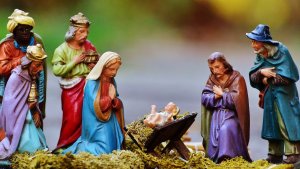Catholic parents all have the same goal: helping their children to focus on the real meaning of Christmas amid all the excitement of Santa Claus and gifts. With hearts set on this goal, we can concoct fantastic ideas — but which are difficult to execute in practice (“Let’s sing Christmas carols all around the neighborhood!” “Let’s visit the assisted living center and bring gifts!”).
We might have better outcomes if we try small, targeted practices such as these.
1Go ahead and enjoy the gift-receiving
Don’t fight the material aspect of Christmas. Whether our children are young or teenagers, they are eager to open gifts. That’s not a bad thing. Do not try to thwart their energy for receiving. Take delight in their enthusiasm and innocence.
2But do give to charity
Invite your children give to charity on Christmas. Young or not so young, let your children bring some money of their own to put in the offertory box at Christmas Mass. In this action we can communicate clearly that Christmas is about giving, not just receiving.
3Call on Scripture
Read the account of Christ’s birth before Christmas Eve dinner. The scene recounting Jesus’ birth is short and sweet: Luke 2:8-20 can be read as our blessing for the meal.
4Contemplate the parish crèche
Pray in front of the crèche in your parish as a family after every Mass of the Christmas season. Just as the birth of Christ made God visible, the crèche imagines the moment of Christ’s birth for us. Large, elaborate nativity scenes in churches aid our meditation on this awesome event. When Mass ends, kneel down before the crèche and spend a few minutes in prayer alongside your children. For the youngest ones, identify the key aspects of the scene.
5And don’t forget Christmas is just getting started
Make the Christmas season a thing. Christmas begins December 25 and then continues for 12 days. The season can be celebrated with religious-themed Christmas carols (“Hark the Herald” and “God Rest You, Merry Gentlemen” are noteworthy for how they delve into the mystery of the incarnation). Continue to extend the “Merry Christmas” greeting to family and friends. Discuss the liturgical feasts of Christmas week and how they point to Jesus—St. Stephen, St. John, the Holy Innocents, the Solemnity of Mary, Mother of God. Make a point of explaining why you will keep your house decorated until at least January 6 even as others begin to take their decorations down.
David G. Bonagura, Jr. is the author of Steadfast in Faith and Staying with the Catholic Church.


